Archive for May 2017
Beef-eating ban in Hindu India
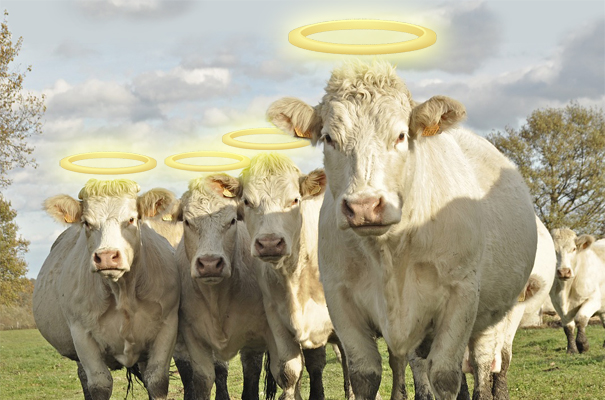
The Holy Cow represents Mother Earth
In 24 out of 29 Indian states the consumption of beef is banned. Restaurant owners who have beef dishes on the menu are fined and jailed.
Koran 5:3—You are forbidden (to eat) carrion, blood, and the flesh of swine.
Koran 22:36—CAMELS: When you draw them up in line for slaughter and they have fallen to the ground eat of their flesh.
Old Testament Bible: Book of Genesis 9:14—You must not eat meat that has its lifeblood in it.
Book of Deuteronomy 12:23—Be sure you do not eat the blood, because the blood is the life; pour it out on the ground like water.
JUDAISM: Shehita is a a special method of slaughtering animals. With a special razor sharp knife an incision is made across the neck of the animal ‘in a single swift sweep’. The cut severs the main arteries, rendering the animal unconscious and permitting the blood to drain from the body.
Jews and Muslims may eat ritually slaughtered meat that is sold/labeled as Kosher/Halal.

Jews and Muslims are forbidden to eat the flesh of swine/pigs because they are considered unclean
HORSE MEAT is eaten in some European countries

In the West, cats and dogs are venerated pets and eating their meat is a crime

ESSAY 9
ESSAY 9
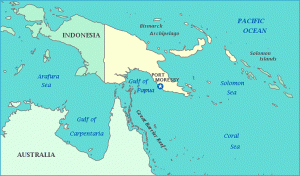
In 1956 in Papua New Guinea an unknown disease was discovered; about 35000 individuals among some 160 villages were infected. Every year some died of uncontrollable “shakings”—hence its local name “kuru”—a degenerative disease of the central nervous system with a gradual loss of coordination of voluntary movements followed by multiple infections. The cause was a slow-acting resistant virus similar to mad cow disease.
Mostly women were struck by kuru and this had sociological consequences—a large proportion of single men and widowers were caring for families. It turned out that the women had indulged in cannibalism, eating the corpses of close relatives out of respect for them. The flesh and brains were cooked and the bones were ground up.
Kuru declined when outsiders/whites arrived on the island and cannibalism became no longer a practice.
Another degenerate ailment of the nervous system is Creutzfeldt-Jakob disease—identical to kuru.
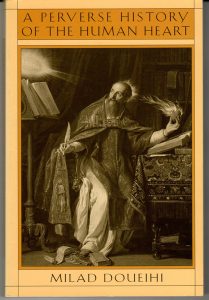
Le Coeur Mangé
(Jean-Pierre Camus: 1584-1652)
The legend of “the eaten heart”
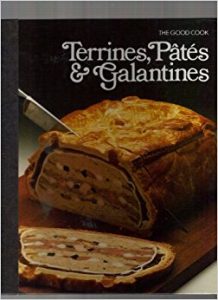
Memnon, a not rich young man, falls in love with gorgeous Crisele. Her parents finally agree to a future wedding. One day an old, rich widower falls in love with the beautiful young Crisele. The parents persuade their daughter to marry the rich widower.
However, Crisele still loves Memnon and she asks him to leave their town. He enlists in the army and fights in Flanders where he is fatally wounded. Before he dies he writes Crisele a letter and asks a relative to take his heart to his lover. Crisele buries Memnon’s heart in a church cemetery and devotes herself to mourning the loss of her young lover
The old husband has pangs of jealousy watching Crisele’s devotion. So one day he has Memnon’s heart stolen from its grave and orders his cook to prepare it as a “paté.” He then serves his wife the heart of her lover. When Crisele discovers she has eaten Memnon’s heart, she tells the relative who had given her the heart. He kills the old husband in a duel.
Crisele spends the rest of her life in a convent. In spiritual terms this entry is a new beginning: a new life founded on the promised return of the dead and the eventual reunion with Christ. The Eucharist recapitulates the original sin occasioned by the eating of the forbidden fruit—magical metaphor of “food” (the sacred heart) becomes a body: an edible body.
(Gospel of John 6:54—whoever eats my flesh and drinks my blood has eternal life)
Old Testament book of Isaiah
14:11-- maggots are your bed and worms are your blanket
The practice of cannibalism was to meet nutritional needs; political act/revenge against enemies; magical function/assimilation of the virtues of the deceased or casting out their souls, and as a religious ritual—a feast of the dead.
Book of Judith (Vulgate)
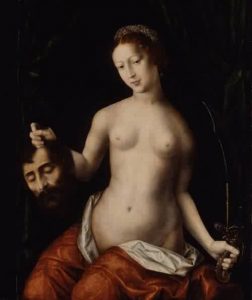
The siege of Bethulia
The Assyrian general Holofernes was warned not to attack the Jews as they were a people supported by God. Judith, a widow, accompanied by her maid servant left the city in a hurry pretending to flee and on her way told Holofernes that he would be victorious. The general invited Judith into his tent. She then tricked him by seducing him with her charms and plenty of wine so that he fell in a deep sleep. Grim-faced, she cut of his head. Triumphantly, Judith then brought the general’s head to Bethulia and a Jewish victory followed
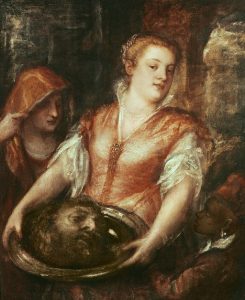
At a party given by king Herod, Salome, daughter of Herodias, second wife of Herod, is enchanted by Jochanaan’s (John the Baptist) voice from the cistern, where he is “imprisoned”, insulting her mother. She orders the guards to allow him out. Jochanaan rants against her and her mother. Enraptured, Salome wants to touch and kiss him but he curses her and returns to his cell.
Herod asks stepdaughter Salome to dance her famous “dance of the seven veils”. She agrees only when he offered her anything she wants to choose. Salome dances and then claims her reward: the head of Jochanaan on a silver platter. The executioner comes up with his head. Salome kisses his mouth. Horrified, Herod orders his soldiers to kill her.
Imagination is the beginning of all magical operations
(Einstein: Imagination is more important than knowledge)
